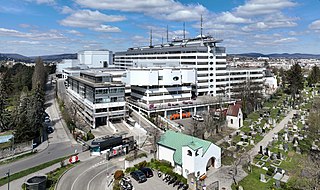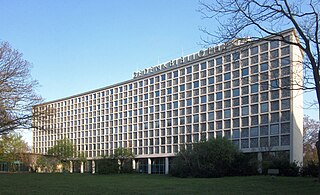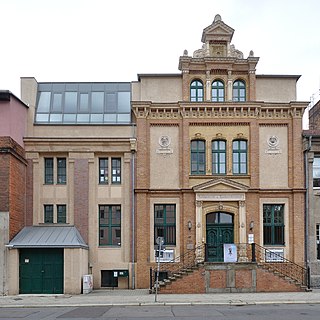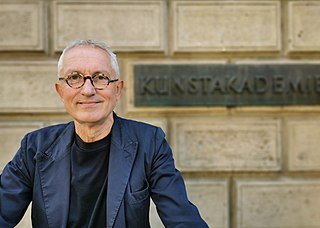Related Research Articles

The Academy of Arts is a state arts institution in Berlin, Germany. The task of the Academy is to promote art, as well as to advise and support the states of Germany.
Burkard Hillebrands is a German physicist and professor of physics. He is the leader of the magnetism research group in the Department of Physics at the Technische Universität Kaiserslautern.

Bernhard Hans Henry Scharoun was a German architect best known for designing the Berliner Philharmonie and the Schminke House in Löbau, Saxony. He was an important exponent of organic and expressionist architecture.

The Gottfried Wilhelm Leibniz Prize, or Leibniz Prize, is awarded by the German Research Foundation to "exceptional scientists and academics for their outstanding achievements in the field of research". Since 1986, up to ten prizes have been awarded annually to individuals or research groups working at a research institution in Germany or at a German research institution abroad. It is considered the most important research award in Germany.

The Berlin-Brandenburg capital region is one of the most prolific centers of higher education and research in the world. It is the largest concentration of universities and colleges in Germany. The city has four public research universities and 27 private, professional and technical colleges (Hochschulen), offering a wide range of disciplines. Access to the German university system is tuition free.

Roland Rainer was an Austrian architect.

Fritz Bornemann was a German architect.

A Kunstgewerbeschule was a type of vocational arts school that existed in German-speaking countries from the mid-19th century. The term Werkkunstschule was also used for these schools. From the 1920s and after World War II, most of them either merged into universities or closed, although some continued until the 1970s.
Thomas Herzog is a German architect from Munich known for his focus on climate and energy use through the use of technologically advanced architectural skins. He began with an interest in pneumatics and became Germany's youngest architecture professor at the age of 32. He established his firm Herzog + Partner in 1983.
Johannes Wallmann was a German Protestant theologian and emeritus professor of church history at the Ruhr-Universität Bochum.
Szyszkowitz + Kowalski is an Austrian-German architectural design team made up of Karla Kowalski and Michael Szyszkowitz. Their studio in Graz was established in 1978. Szyszkowitz + Kowalski are regarded to be major co-founders of the internationally renowned Grazer Schule. Originating in Graz in the 1970s, this name stands for architectural individualism of an especially creative type. Szyszkowitz + Kowalski put great emphasis on three-dimensional and expressive architectural language with a distinctive reference to landscape and context.

Sep Ruf was a German architect and designer strongly associated with the Bauhaus group. He was one of the representatives of modern architecture in Germany after World War II. His elegant buildings received high credits in Germany and Europe and his German pavilion of the Expo 58 in Brussels, built together with Egon Eiermann, achieved worldwide recognition. He attended the Interbau 1957 in Berlin-Hansaviertel and was one of the three architects who had the top secret order to create the governmental buildings in the new capital city of the Federal Republic of Germany, Bonn. His best known building was the residence for the Federal Chancellor of the Federal Republic of Germany, built for Ludwig Erhard, the so-called Chancellor's Bungalow.
Stefanie Schüler-Springorum is a German historian.

Jan Wagner is a German poet, essayist and translator, recipient of the Georg Büchner Prize and Leipzig Book Fair Prize.

Barbara Ruth Albert is a German chemist and rector of the University of Duisburg-Essen. She was Professor of Solid State Chemistry at the Eduard-Zintl-Institute for Inorganic and Physical Chemistry of the Technische Universität Darmstadt. From 2012 to 2013 she was the president of the German Chemical Society.

Jean-Philippe Vassal is a French architect and academic. He runs the architectural practice Lacaton & Vassal, with Anne Lacaton. The pair were jointly awarded the 2021 Pritzker Architecture Prize.

Stefan Polónyi was a Hungarian-born German civil engineer.

Karl-Heinz Petzinka is a German architect, and Rector of the Kunstakademie Düsseldorf. He is known for office buildings in Düsseldorf and Berlin. He converted historic industrial buildings, and was responsible for the section architecture for the Ruhr.2010 project.
References
- 1 2 "Sieverts". Akademie der Künste, Berlin (in German). Retrieved 25 November 2021.
- ↑ "Tom Sieverts zum Geburtstag". Urban INDEX Institut (in German). Retrieved 25 November 2021.
- ↑ "Die Zwischenstadt birgt ungehobene Schätze". werk, bauen + wohnen (in German). Retrieved 25 November 2021.
- 1 2 3 "Architektur-Positionen Thomas Sieverts". Technische Universität Kaiserslautern – TU Kaiserslautern (in German). Retrieved 25 November 2021.
- ↑ "Biografie WHO'S WHO". Thomas Sieverts (in German). Retrieved 25 November 2021.
- ↑ "Thomas Sieverts". Global Suburbanisms. 25 November 2021. Retrieved 25 November 2021.
- ↑ "Thomas Sieverts". SKuOR – Interdisciplinary Centre for Urban Culture and Public Space. Retrieved 25 November 2021.
- ↑ "Thomas Sieverts". Sächsische Akademie der Künste (in German). Retrieved 25 November 2021.